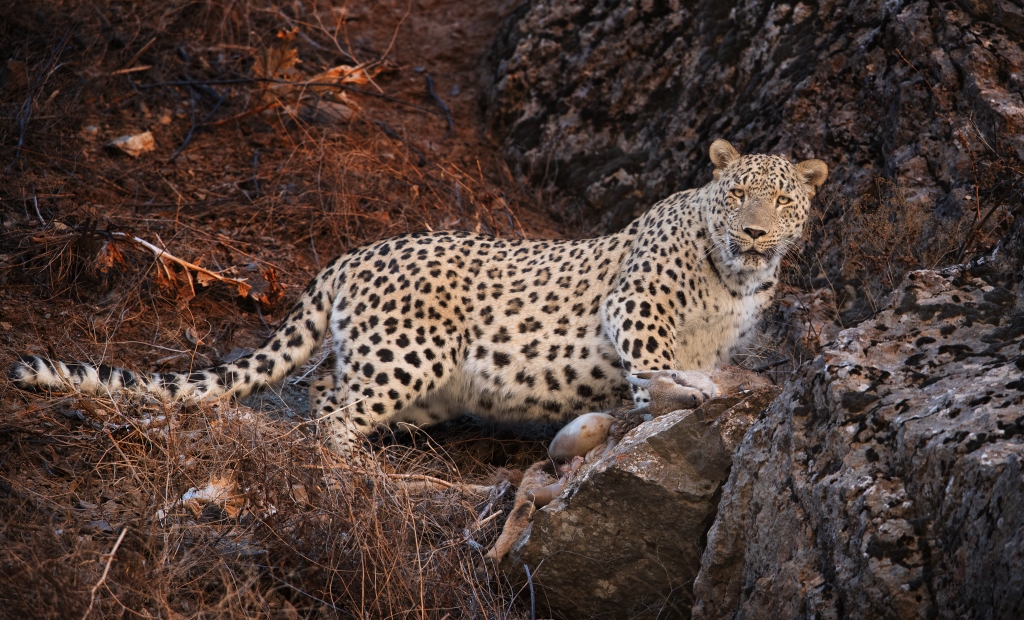Shortlisted for the Southwood Prize 2022
Mahmood Soofi talks us through his research project which saw him and colleagues use ranger-collected data on illegal leopard killings in Iran and an N-mixture model to quantify relationships between livestock, prey density and illegal killing.
Overexploitation and carnivores
Overexploitation is one of the major threats to biodiversity in many parts of the world, which is driving many species to extinction. Large carnivores are especially suspectable to population declines and range loss. Due to requirements for vast areas, large wild prey base and high energy intake, large carnivores often retreat into areas where the risk of human pressures, such as illegal killings or road mortality, are higher.
In practice, illegal killing of carnivores is not uncommon, given that over one-third of the global land area is currently used for livestock production, which exacerbates human-wildlife conflicts leading to illegal killing.

Managing illegal killing
To halt illegal killing activities, rangers in protected areas of Asia and Africa are mainly responsible for monitoring non-compliance and imposing pre-defined sanctions on rule breakers. For example, in Iran, rangers perform daily patrols around their assigned ranger station and regularly document their seizures of wildlife crimes and sightings. Such data is collected at great expense, placing rangers at risk of injury or even death. Therefore, it is crucial to make the most use of such data to help guide conservation efforts.
One of the main challenges in managing illegal killing activities is the difficulty in quantifying rates of illegal killing accurately – it occurs clandestinely, which makes its detection notoriously difficult. Illegal killing events leave limited traces and can often only be detected in areas where law enforcement measures are in place.
So, there is a chance that illegal events might go undetected, especially in areas with fewer patrols or areas which lack law enforcement measures altogether. Thus, special attention is needed to quantify the ‘true’ magnitude of illegally killed animals with the use of statistical approaches that account for imperfect detection.
The study
So, our work addresses the following question: how can ranger-collected data be used to quantify the annualized illegal killing intensity of leopards across Iran? To do this, we used a class of models referred to as the N-mixture model (Royle, 2004) which relates observed event counts to the true number of events that may not be observed due to imperfect detection. We also sought to investigate how livestock density and wild prey abundance affect the illegal killing events of leopards over time.
Together with my co-authors at the University of Göttingen, Germany, USGS Eastern Ecological Science Center (Patuxent Refuge), Maryland, USA, and CSIRO, Darwin Australia, and Humboldt University of Berlin, Germany, and Shahid Beheshti University, Iran, we used ranger-collected data on illegal killings of leopards across protected and non-protected areas in Iran.
Such country-wide time-series data collected by rangers is rare and this research is the first to quantify illegal killing intensities of a large carnivore at a large scale. We quantified annualized leopards’ killings and assessed its key drivers using a single-visit N-mixture model (Sólymos et al. 2012).
The findings
Across the thirteen year study period, we estimated over 1000 leopards (32 individuals per year) have been illegally killed across the country. Our study identified several key human-induced threats that affected the illegal killing of leopards:
- First, the expected number of illegal kill events is positively affected by livestock density, which is a very common practice in our study area
- Second, our study identified a higher expected frequency of leopard killing events in larger protected areas. Larger protected areas may hold higher populations of leopards and, therefore, lead to more dispersal
- Thirdly, we found that leopard killing events were more likely to be detected by rangers in areas of greater road density (>300 km of roads per 400 km2 grid cell).
We believe that the single-visit N-mixture model can be a useful statistical tool for dealing with similar conservation threats involving different wildlife species in various regions and wildlife monitoring data.
About the author
Mahmood Soofi is a Feodor Lynen Research Fellow of the Humboldt Foundation based at CSIRO, Darwin, Australia, and the University of Göttingen, Germany. He has been a honorary research fellow (German Academic Exchange Service -Postdoctoral Researchers International Mobility Experience, DAAD-PRIME) at the University of Aberdeen, Scotland, UK and the University of Gottingen, Germany. He obtained his PhD from University of Göttingen.
He is a conservation scientist whose work spans wildlife monitoring, population ecology, human-wildlife conflict, understanding how social, ecological, and behavioural factors interact and how they affect key issues in biodiversity conservation with a focus on large mammals.
Mahmood’s current research focuses on understanding the drivers of conservation conflicts particularly people who participate in unlawful harvests, planning for effective and socially just conservation, and accounting for social-ecological system dynamics. Mahmood seeks to understand and improve the effectiveness of protected areas through evaluating conservation interventions and developing approaches to mitigate/transform conflicts.
The research article published in the Journal of Applied Ecology is one of the papers of his current postdoc projects, and he is grateful for the support and advice from all his mentors, authors, and lab mates.
Read the full article, “Quantifying the relationship between prey density, livestock and illegal killing of leopards” in Journal of Applied Ecology
Find the other early career researchers and their articles that have been shortlisted for the 2022 Southwood Prize here!
